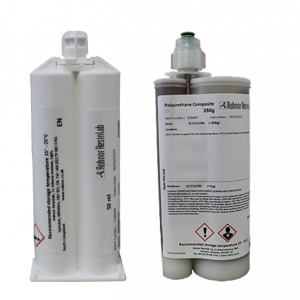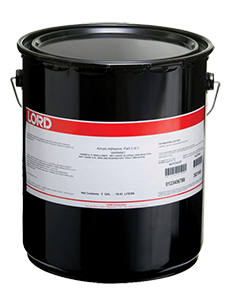A basic question that many design engineers have when thinking about assembling their products is: What are the differences between adhesives and sealants, which jobs are they best at, and how do I decide which ones to use for which materials and applications?
Because adhesives and sealants can sometimes be made of similar materials, with similar processing times, the differences aren’t always obvious. Although certain chemistries work better as one or the other, many adhesive technologies can also be formulated as sealants. However, sealants don’t usually have enough adhesion ability to hold two surfaces together. They are not used as primary bonding materials and are subject to creep under load. Sealants are usually used on outside surfaces.
What are the main differences between adhesives and sealants?
The main differences between adhesives and sealants are strength, and other physical characteristics associated with strength. Generally, adhesives have higher strength and lower elongation at break than sealants: adhesives are generally over 1000 psi lap shear while sealants are less than 1000 psi lap shear.
Consequently, adhesives are more rigid and durable than sealants, since they’re designed to keep two surfaces stuck to each other over long periods of time strongly enough so they can’t be separated. They have a more highly cross-linked, more complex molecular structure than that of sealants, which aids their ability to grip and bind surfaces together. They also have greater cohesiveness, which results in higher strength values.
Adhesives are usually divided into three basic types: physically hardened, chemically cured, and pressure-sensitive. Physically hardened adhesives begin in a liquid form that hardens after application, and come in one of three types: organic solvent, water-based, or hot melt. They can have a wide range of properties and uses, and they have widely ranging chemistries. Chemically cured adhesives, both one- and two-component, are generally very strong and resistant to temperature, humidity, and many chemicals. Their chemistries include cyanoacrylates, silicones, methyl methacrylates, and urethanes. Pressure-sensitive adhesives remain viscous and don’t completely solidify, so temperature and load can affect the quality of the bond they form.
Sealants are much more flexible than adhesives, since they usually contain an elastomer, with a molecular structure that is loosely cross-linked and a generally paste-like consistency. This lets them fill gaps between the surfaces of components or substrates to form air-tight and water-tight barriers. Compared to adhesives, sealants generally have higher rates of shrinkage.
Sealants are usually divided into three types: one-component, two-component, and tapes. One-component types are the most common and can be easily applied, and chemistries include silicone, urethane, solvent-based acrylics, solvent-based butyls, water-based latex, silyl-modified polymer (SMP), and polysulfides. Two-component types, comprising an activator and a base component, require mixing equipment and applicators. Their chemistries include silicone, urethane, and polysulfides. Sealant tape types are most commonly butyl chemistries.
What are the different uses for the two materials?
When deciding what type of adhesive or sealant to choose, engineers must ask themselves several different questions to identify how it will be used in their applications.
Initial questions include what is the material the object being bonded is made of and what conditions does it need to survive? First, is it a structural or a non-structural bond? Does the bond have to support a load-bearing object? In that case a structural adhesive is required. Or it is being attached to something else that’s doing the load bearing, such as rivets or welding? In that case either a non-structural adhesive or a sealant is needed, depending on the job to be done.
Next, when choosing either an adhesive or a sealant, what are the substrate materials, and the thermal and environmental conditions the bond must withstand? Some adhesives are much better at bonding to certain types of substrate materials, such as ceramic, glass, or specific metals and plastics. Environmental conditions may include the types of stresses — compressive, tensile or torsion, intermittent or constant — and the load, operating temperature, and chemical exposure a bond will be used in. More specialized conditions may be a need to provide thermal or acoustical insulation, electrical properties, optical properties, or UV stability, to act as a fire barrier, or to display a certain surface appearance.
Other considerations may include bonding substrates with different mechanical properties, such as different elongations under stress or different coefficients of thermal expansion. For sealants, this will require enough elongation and flexibility to accommodate the requirements of both substrate materials. Low shrinkage after application may also be required.
Additional conditions for adhesives may include different types of surface preparation required, whether the bond gap must be thin or thick, whether the part is horizontally or vertically oriented, required working life and application equipment, and whether thermal or ultraviolet (UV) curing is needed. All of these, and other considerations, can affect how easily the adhesives can be integrated into the existing production line.
After making these decisions, engineers can begin selecting specific chemistries.
Application Examples:
Adhesives of all types are used in an extremely wide variety of commercial and industrial applications. Here is a sampling:
- Electric motor magnet bonding

- Telephone pole repair
- Bowling alley repair
- Structural composite bonding
- Medical device assembly
- Interior panel bonding
- Honeycomb edge fill
- General repair of aircraft
- Automotive seam sealing, body panel bonding, and trim pieces.
Applications for one-component sealants include silicone and water-based household caulk, urethanes for marine repair and RV skin bonding, solvent-based acrylics for general-purpose plastic and metal bonding, solvent-based butyl roof sealants, and polysulfide or SMP window sealants. Butyl tapes are used for weatherstripping and appliance assembly.
Two-component types are generally used for more demanding applications. These include urethanes for windshield bonding, polysulfide aircraft and military fuel tank sealants, and silicones for encapsulation or as foams for fire barriers in construction.
 Shop our wide range of adhesives & sealants.
Shop our wide range of adhesives & sealants.
Additional Links
If you have any questions about adhesive tapes, we know a man who can help! Ask The Ellsworth Adhesives Glue Doctor!
The content for this month’s blog post was provided by Gluespec® – a service of Ellsworth Adhesives.
Gluespec helps engineers to discover adhesives and other materials for their industrial applications.

